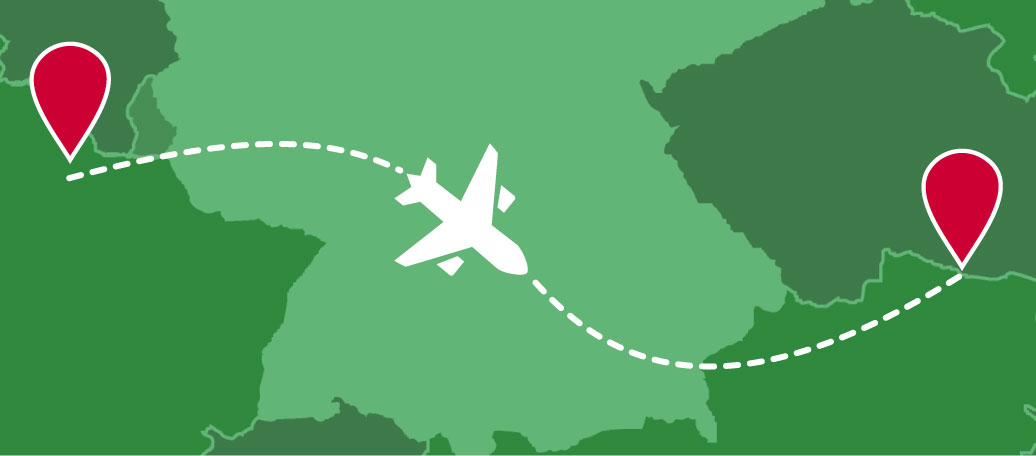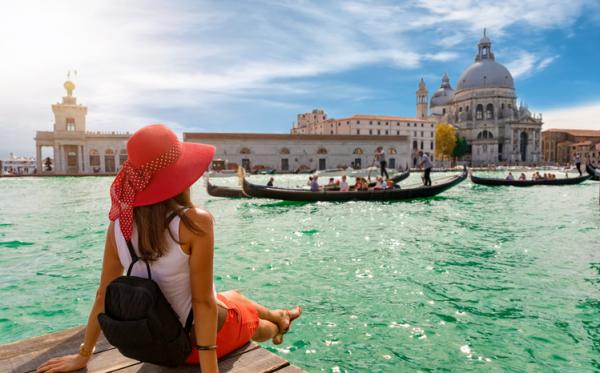What's travel insurance?
Travel insurance, also known as holiday insurance, protects you and your family against unexpected costs while you're travelling or on holiday.
While it isn't a legal requirement, it covers the cost of things like medical expenses if you get ill or injured abroad, trip cancellation, stolen personal belongings and lost luggage.
What's covered
Here are some key features of our travel insurance. As with any insurance, policy limits and exclusions apply, so always read your policy book.
Emergency medical expenses
We cover reasonable and necessary emergency medical treatment costs if you get ill or injured in an accident abroad.
Delayed or missed departure
If you're delayed or miss your transport due to unforeseen circumstances, we'll cover reasonable costs for accommodation and travel.
Lost or stolen personal belongings
If your belongings are lost, stolen or damaged accidentally (or deliberately by someone else), you can claim up to your policy limits.
Cancelling or cutting your trip short
We'll cover costs up to your policy limit for things like deposits or parking fees if you have to unexpectedly cancel or cut short your trip.
Personal liability and legal assistance
We'll support you with legal costs to help you claim damages or compensation for injury, illness or death during your trip.
Specific COVID-19 related events
Read about how COVID-19 affects your travel insurance on our dedicated FAQ page.
What isn’t covered by travel insurance?
This list isn’t exhaustive and doesn’t include exclusions for our specialist travel insurance like adventurous sport and winter sport.
- flights cancelled or delayed for any reason other than severe weather conditions, strike, or mechanical breakdown (unless you’ve bought extra cover)
- claims related to flights that don't start or end in the UK (connected flights), unless you’ve bought extra cover
- trip cancellation because you’ve changed your mind
- pre-existing conditions you've not declared
- claims related to death or illness of someone not on the policy linked to pre-existing conditions they had at any time before you bought your policy
- lost or stolen items you've left unattended
- claims where you can't give us evidence, for example, a police report or receipts
- being denied entry because you don't have passports or the correct visas
- extreme sports, winter sports or cruise trips unless you've paid for the additional cover
- circumstances that aren’t specified in your policy
However, check your policy book for all exclusions.
Choose from three levels of cover
We have three cover levels for you to choose from, depending on the level of protection you want for your next trip.
| Admiral | Admiral Gold |
Admiral Platinum |
|
|---|---|---|---|
| Emergency medical treatment and repatriation | £10M | £15M | £20M |
| Cancellation or cutting your trip short | £1.5K | £3K | £5K |
| Personal belongings | £1K | £2K | £3K |
| Money and documents | £300 | £400 | £500 |
| Personal accident | £10K | £15K | £25K |
| Personal liability | £3M | £3M | £3M |
| Legal assistance | £20K | £20K | £30K |
| Catastrophe cover | £1K | £1.5K | |
| Excess | £100 | £75 | £50 |
Why do I need Travel Insurance?
Choosing a travel insurance policy that suits your needs offers financial protection against travel-related emergencies. In particular, getting ill abroad can be very expensive as most countries don't provide free medical care in the same way as in the UK.
For example, in the US, you're charged for an ambulance call out, meaning a trip to the hospital could cost tens of thousands of pounds.
If you're travelling to an EU country or Switzerland, a GHIC card can reduce the cost of medical expenses or make them free of charge, but it won’t fully cover you for medical treatment or repatriation. Read more about getting a GHIC card here.
What type of travel insurance is best for me?
Whether you're flying solo or travelling with your friends and family, we cover the UK, Europe and worldwide.

Single Trip Insurance
Cover for one trip lasting up to 365 days for travellers aged 18 up to 100 years, depending on the destination.

Annual Travel Insurance
Cover for 12 months on an unlimited number of trips lasting up to 31 days each. This is for travellers aged 18 up to 90, depending on region of cover
If you need cover for trips longer than 31 days, you can select the required trip length when completing your quote (subject to eligibility).
How to get cheaper travel insurance
There are a few things you can do to lower your travel insurance costs:
Choose the right policy type |
If you’re planning multiple trips in the next year, an annual travel insurance policy is usually cheaper than buying a single trip policy for each trip. |
|
|---|---|---|
Check your home insurance |
Protecting your personal belongings abroad is important, but many home or contents policies cover your things away from home. |
|
Combine your policy |
It might be cheaper to buy group travel insurance if you’re travelling with your family or your partner. |
Travelling with pre-existing medical conditions
A pre-existing condition is any short or long-term illness, injury or medical condition that you've had at any time before buying travel insurance. This includes conditions that may have been treated with one-off or repeat prescriptions or, which have now been resolved.
A pre-existing condition includes things like urinary tract infections, diabetes, cancer and heart conditions. A pre-existing condition will:
- have been identified by a medical professional before taking out a policy or
- be symptoms that are being investigated by a medical professional (e.g. you’re waiting for tests, scans) or
- be a diagnosed condition you’re waiting to be treated for by a medical professional (e.g. surgery)
You can declare your pre-existing conditions during the quote process to see if we can cover them. It’s really important that you tell us about your pre-existing conditions and give us the right information, because if you don’t, we could cancel your policy or not pay for any claim you make, even if it’s not related to the condition.
If you’re not sure what needs to be declared, visit our medical conditions page to find out more.
MoneyHelper directory
If we can't cover your medical condition, you can use the MoneyHelper directory to find a specialist insurer who might be able to cover you if you've been:
- refused travel insurance or had your policy cancelled
- offered cover with a medical exclusion that you can't remove from your policy
- quoted a price for a travel insurance policy with high medical costs
MoneyHelper makes it easier to find and compare policies you can afford that cover your condition and medical needs. Access the MoneyHelper directory online or call MoneyHelper on 0800 138 7777 (phone lines are open Monday to Friday 8:00am - 6:00pm, excluding bank holidays).
Visit the MoneyHelper DirectoryHow to claim on your travel insurance
We may ask for original receipts, invoices or medical records to support your claim.
Read your policy book
Check that we cover the event you want to claim for
Prepare your information
You'll need documents to support your claim
Contact us
Visit our make a claim page for our contact details or log into MyAccount
Read more about our customers' experiences
We care what our customers have to say about us.
How we calculate your travel insurance premium
We use multiple factors to calculate travel insurance prices. We constantly check the prices we charge to offer you the best travel insurance premium, but prices also fluctuate depending on the market. Here are a few factors:
- Where you’re going — where you’re going heavily influences how much you’ll pay for travel insurance. The destination tells us how expensive medical treatment is and how much it’d cost to fly you home in an emergency.
- How long you’re going for — simply put, the longer you’re away from home, the higher the risk of you having an accident or losing your things.
- Who you’re travelling with — the age and medical history of everyone travelling impacts your premium price.
- Any medical conditions — depending on the severity of the condition (and, therefore, the potential cost and likelihood of treatment), your premium is likely to be higher.
- The cost of medical treatments — on average, the cost of medical treatment is higher outside of Europe. Plus UK citizens can use a GHIC card in the EU to access treatment and, in some cases, reduce the cost.
- What you’ll do on your trip — you increase your risk of injury on winter sports trips, meaning it’ll cost more to insure. But, without specialist cover, any related claims will be rejected.
- What’s going on in the world — currency fluctuations can make it more expensive for us to settle claims with companies or services based abroad. Increased risk of terrorism, airline strikes or natural disasters will also impact your premium.
- Insurance Premium Tax (IPT) — by law, we add a 20% tax to your travel insurance premium. Read more about why we do this.
How to get a travel insurance quote
We need to know a few things to get your quote
What type of travel insurance you need
Do you have one trip planned or multiple trips for the year?
About your trip
- Your destination or region
- How long you're going for
- Who you're travelling with
Traveller details
- Name
- Date of Birth
- Address
- Contact information
Any medical conditions
Let us know if you have any medical conditions we need to know about.
View other travel insurance options
Going anywhere nice?
Off to one of the destinations below? Take a look at our guides for some hints and tips on what you need to remember.
Travel insurance that suits you
Whether you're travelling solo, with your family, or with a little one on the way, read our guides to make sure our cover is right for you.
Travel Insurance upgrades
Whether you want the adrenaline rush of a skiing holiday, or fancy taking to the seas on a cruise, you'll need to add extra cover to your policy.



